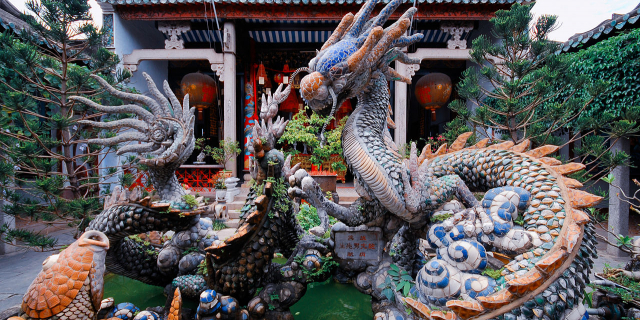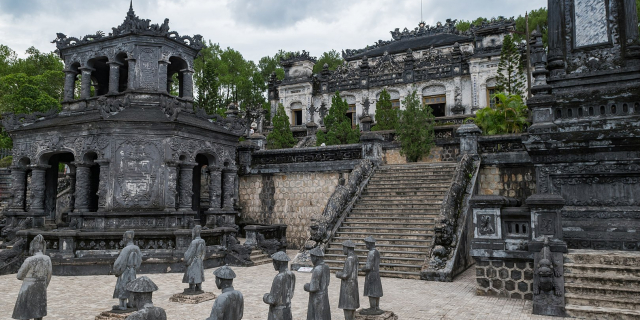Hội An
Hội An (Vietnamese: [hôjˀ aːn] ), formerly known in the Western world as Faifoo or Faifo, is a city with a population of approximately 120,000 in Vietnam's Quảng Nam Province, registered as a UNESCO World Heritage Site since 1999. Along with the Cù Lao Cham archipelago, it is part of the Cù Lao Cham-Hội An Biosphere Reserve, designated in 2009.
Old Town Hội An, the city's historic district, is recognized as a well-preserved example of a Southeast Asian trading port dating from the 15th to the 19th century, its buildings and street plan reflecting a blend of indigenous and foreign influences. Prominent in the city's old town is its covered "Japanese Bridge", dating to the 16th–17th century.
Between the 7th and 10th centuries, the Chams (people of Champa) controlled the strategic spice trade and with this came increasing wealth.[citation needed]
The early history of Hội An is that of the Chams. These Austronesian-speaking Malayo-Polynesian people created the Kingdom of Champa which occupied much of what is now central and lower Vietnam, from Huế to beyond Nha Trang.[citation needed] Various linguistic connections between Cham and the related Jarai language and the Austronesian languages of Indonesia (particularly Acehnese), Malaysia, and Hainan have been documented. In the early years, Mỹ Sơn was the spiritual capital, Trà Kiệu was the political capital and Hội An was the commercial capital of the Chams, they later moved further down towards Nha Trang. The river system was used for the transport of goods between the highlands, as well as the inland countries of Laos and Thailand and its lowlands.[citation needed]
Vietnamese period Hội An in early 17th century
Hội An in early 17th centuryIn 1306, the Vietnamese and the Chams signed a land treaty, in which Cham king Jaya Simhavarman III gave Đại Việt the two provinces of Ô and Lý in exchange for a long-term peace and marriage with emperor Trần Nhân Tông's daughter Huyền Trân.[1]: 86–87, 205 In 1471, Emperor Lê Thánh Tông of Đại Việt annexed Champa[2] and Hội An became a Vietnamese territory, and also became the capital of Quảng Nam Province.[3]: 23
In 1535, Portuguese explorer and see captain António de Faria, coming from Đà Nẵng, tried to establish a major trading centre at the port village of Faifo.[4] Since 1570, Southern Vietnam had been under the control of the powerful Nguyễn clan, established by governor Nguyễn Hoàng. The Nguyễn lords were far more interested in commercial activity than the Trịnh lords who ruled the north. As a result, Hội An flourished as a trading port and became the most important trade port on the South China sea. Captain William Adams, the English sailor and confidant of Tokugawa Ieyasu, is known to have made one trading mission to Hội An in 1617 on a Red Seal Ship.[5] The early Portuguese Jesuits also had one of their two residences at Hội An.[6]
Hội An was a divided town with the Japanese settlement across the "Japanese Bridge", constructed in the 16th-17th century. The bridge (Chùa Cầu) is a unique covered structure built by Japanese merchants, the only known covered bridge with a Buddhist temple attached on one side. In the 18th century, Hội An was considered by Chinese and Japanese merchants to be the best destination for trading in all of Southeast Asia.[citation needed] The city also rose to prominence as a powerful and exclusive trade conduit between Europe, China, India, and Japan, especially for the ceramic industry. Shipwreck discoveries have shown that Vietnamese and other Asian ceramics were transported from Hội An to as far as the Sinai in Egypt.[7]
 Hội An port in 18th century
Hội An port in 18th century The port town of Hội An and its bridge in the 18th century. Watercolour engraving by Jacques Chereau (1688-1776), circa 1750.
The port town of Hội An and its bridge in the 18th century. Watercolour engraving by Jacques Chereau (1688-1776), circa 1750.Hội An's importance waned sharply at the end of the 18th century because of the collapse of Nguyễn rule, which resulted from the Tây Sơn Rebellion - which was opposed to foreign trade. In 1775, Hội An had been the battleground between the Trịnh army and Tây Sơn rebels, where the city was destroyed in the prices.[3]: 28 Then, with the triumph of Emperor Gia Long, he repaid the French for their aid by giving them exclusive trade rights to the nearby port town of Đà Nẵng. Đà Nẵng became the new center of trade (and later French influence) in central Vietnam while Hội An was a forgotten backwater. Local historians also say that Hội An lost its status as a desirable trade port due to the silting up of the river mouth. The result was that Hội An remained almost untouched by the changes to Vietnam over the next 200 years. The efforts to revive the city were only done in the 1990s by a Polish architect and conservator from Lublin and influential cultural educator, Kazimierz Kwiatkowski, who finally brought back Hội An to the world. There is a statue of the Polish architect in the city, and remains a symbol of the relationship between Poland and Vietnam, which share many historical similarities despite their distance.[8]
Today, the town is a tourist attraction because of its history, traditional architecture, and crafts such as textiles and ceramics. Many bars, hotels, and resorts have been constructed both in Hội An and the surrounding area. The port mouth and boats are still used for both fishing and tourism.[citation needed]
























![Jérémie B. - CC BY-SA 4.0 [node:title]](/sites/default/files/styles/640x320/public/pla/images/2021-03/Hang_%C3%89n_Cave_-_201505_-_JB.jpg?h=1c9b88c9&itok=-XbNuGkx)





![Doug Knuth from Woodstock, IL - CC BY-SA 2.0 [node:title]](/sites/default/files/styles/640x320/public/pla/images/2021-03/Son_Doong_Cave_5_0.jpg?h=d2afc48b&itok=J-ENajWM)


Add new comment